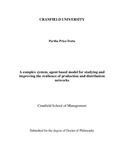JavaScript is disabled for your browser. Some features of this site may not work without it.
| dc.contributor.advisor | Allen, Peter M. | |
| dc.contributor.advisor | Christopher, Martin | |
| dc.contributor.author | Datta, Partha Priya | |
| dc.date.accessioned | 2007-06-21T13:34:33Z | |
| dc.date.available | 2007-06-21T13:34:33Z | |
| dc.date.issued | 2007-03 | |
| dc.identifier.uri | http://hdl.handle.net/1826/1757 | |
| dc.description.abstract | The very complexity and the extended reach of today’s globe-spanning supply chain networks, the low inventory levels and lack of redundancies required to achieve efficient operations expose businesses to a huge range of unexpected disruptions. This calls for building resilience in supply chains, which is not just recovery from the mishaps, but is a proactive, structured and integrated exploration of capabilities within the supply chain to resist and win against unforeseen happenings. Literature on supply chain and organisational resilience are informative in identifying resilience enhancing strategies and capabilities, but a detailed dynamic analysis of behaviour of the supply chain to understand the suitability of different resilience capabilities over time and under different scenarios is not carried out. The thesis addresses this gap by studying the internal decision making mechanisms, rules and control procedures through development of an agent-based model and its application to a paper tissue manufacturing supply chain. The model with a decentralised informational structure with informed and intelligent combination of push or pull type of replenishment strategy, flexibility, agility, redundancy and efficiency is found to enhance the resilience of the actual supply network in the face of large deviation of demand from forecasts. The effects of adopting several resilience improvement strategies in tandem or in isolation and the impact of applying different behavioural rules by different agents are studied in this thesis by carrying out numerical experimentation. The findings from the experiments suggest that, however flexible the resources are, however well-informed the different members are, however well-integrated the members are through coordination and communication, however wellequipped a supply chain is with mitigation and recovery capabilities the individual managerial judgements that can obtain a balance between various dimensions of performance (both global and local efficiency, quality and speed of responding to customer orders) and resilience (speedy reaction, maintaining buffers, flexibility in resource management) play the most important role in improving the resilience of the entire network. An important contribution of this thesis is to produce a conceptual framework for supply chain resilience. This framework is used to test the appropriateness of different resilience enhancement procedures. Another significant contribution of this thesis is to provide a theoretical template for further research in supply chain resilience. The template will guide development of effective procedures for managing different situations of uncertainty. By using complex systems modelling methods, such as multi-agent models described in the thesis, outcomes of the system under a significant range of possible agent behavioural rules and environmental events can be explored, and improved levels of functioning and of resilience can be found. Building such models as a means to understand and improve resilience of supply networks is a significant contribution. | en |
| dc.format.extent | 5252006 bytes | |
| dc.format.mimetype | application/pdf | |
| dc.language.iso | en | en |
| dc.publisher | Cranfield University | en |
| dc.rights | © Cranfield University 2007. All rights reserved. No part of this publication may be reproduced without the written permission of the copyright owner. | en |
| dc.title | A complex system, agent based model for studying and improving the resilience of production and distribution networks | en |
| dc.type | Thesis or dissertation | en |
| dc.type.qualificationlevel | Doctoral | en |
| dc.type.qualificationname | PhD | en |
